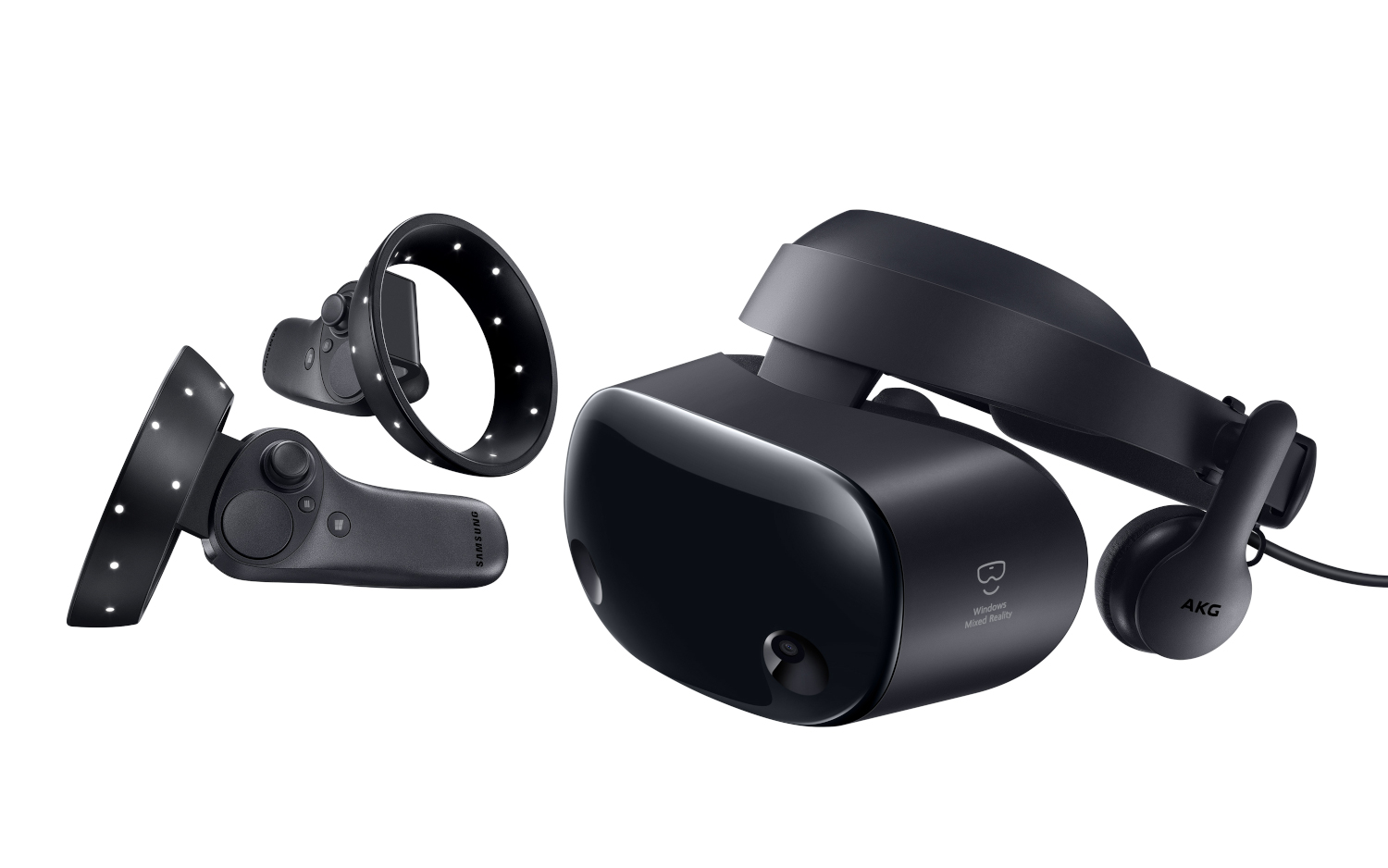Samsung Fights VR's Screen Door Effect, Doubles PPI With HMD Odyssey+
Samsung arrived late to the Windows Mixed Reality (MR) lineup. Microsoft's attempt to make VR accessible to as many Windows users as possible was initially dominated by so-so headsets that couldn't really compete with the Oculus Rift, HTC Vive and other premium VR devices. That changed with the release of the Samsung HMD Odyssey in March. Less than a year after the headset's debut, Samsung is back at it with a refined headset in the Samsung HMD Odyssey+ announced today.
We praised the original HMD Odyssey in our review for offering a far better experience than competitive Windows MR headsets. The offering cost a lot more than its competition--competitors were available for roughly $200-$250, and the HMD Odyssey was $500--but it justified those prices with far better hardware. That didn't mean it was perfect though, and the HMD Odyssey+ packs numerous upgrades.
Samsung HMD Odyssey and Odyssey+ Specs Comparison
| Name | Samsung HMD Odyssey | Samsung HMD Odyssey+ |
|---|---|---|
| Display Type | AMOLED | AMOLED |
| Display Size | Dual 3.5 inches | Dual 3.5 inches |
| PPI | 615 | 1,233 "perceived" with Anti-Screen Door Effect tech |
| Per-Eye Resolution | 1440 x 1600 | 1440 x 1600 |
| Refresh Rate | 60Hz (integrated GPU) 90Hz (discrete GPU) | 60Hz (integrated GPU) 90Hz (discrete GPU) |
| FOV (HxV) | 110° x ???° | 110° x ???° |
| Lens Type | Fresnel | Unknown |
| Lens Adjustment | 60-72mm mechanical IPD adjustment | Mechanical IPD adjustment |
| Sensors | Accelerometer,Gyro sensor,Magnetometer,Proximity | 2 Windows MR cameras,IPD Sensor,G-Sensor, Gyroscope, Proximity |
| Tracking Technology | 6 DOF inside-out BW camera-based spatial tracking (stereo BW cameras) | 6 DOF inside-out |
| Integrated Camera | Stereo-tracking cameras: no video passthrough | Unknown |
| Audio | Integrated headphones with AKG spatial audio, 2x array microphones | Integrated headphones with AKG spatial audio, 2x array microphones |
| Wireless? | No | Unknown |
| HMD Ports | 1x proprietary cable (HDMI/USB 3.0) | 1x proprietary cable (HDMI/USB 3.0) |
| HMD Cable Length | 13.1ft (4m) | Unknown |
| Dimensions | 7.9 x 5.2 x 4.4 inches (201.9 × 131.6 x 111mm) | Unknown |
| Weight | 1.4lbs (644g) | 1.3lbs (590g) |
The HMD Odyssey+ features dual 3.5-inch AMOLED displays with a combined resolution of 2880 x 1600. That's the same as its predecessor, but the new headset's displays are equipped with Anti-Screen Door Effect (Anti-SDE) technology. The so-called Screen Door Effect occurs when people can see the spaces between pixels in a headset's displays; Samsung claims Anti-SDE solves that problem "by applying a grid that diffuses light coming from each pixel and replicating the picture to areas around each pixel."
"This makes the spaces between pixels near impossible to see. As a result, your eyes perceive the diffused light as part of the visual content, with a perceived PPI of 1,233PPI, double that of the already high 616PPI of the previous generation Samsung HMD Odyssey+," Samsung said in its announcement.
Samsung also worked to make the VR headset's hardware more comfortable. It's down to weighing 590g from the original's 644g, and Samsung says that now "everything, from the headband to the display position, to the Inter-Pupillary Distance (IPD) wheel, is easily adjustable so that anyone can find that perfect fit." That should help people who, say, want to wear their glasses while they use the headset.
Full specs for the HMD Odyssey+ aren't yet available; neither is pricing information. Samsung said it will be available starting today from its online store and the Microsoft store in the U.S., with releases in Korea, China, Hong Kong and Brazil to follow.
Get Tom's Hardware's best news and in-depth reviews, straight to your inbox.

Nathaniel Mott is a freelance news and features writer for Tom's Hardware US, covering breaking news, security, and the silliest aspects of the tech industry.
-
s1mon7 I wonder if they really implemented it on the display level or optics level. My concern is with the loss of sharpness and objects looking blurry-ish, especially if they did this with optics tricks. After all you can blur out the pixels on some VR headsets by reducing the sharpness already, which technically does what they described - you just end up with an image that looks like you're having horrible eyesight issues. I really hope they came up with a better solution, as "dispersing" the image coming from individual pixels just sounds like reducing the sharpness of individual pixels and somehow doesn't sound that good to me unless convinced otherwise. As in, I'd have to see it or see a bunch of reviews clarifying the image doesn't look like potato before I'd buy it.Reply -
claychilde Yet another company using detestable Fresnels - defeats the whole object of improving the display when you've still got lens-flares and ring-ghosting. I'll never purchase another HMD with Fresnel lenses.Reply -
Specter0420 This is horrible news. It sounds like a diffusion layer to me, Razer did it on their HDK2. In that case it was a textured plastic blurring film stuck right to the LCDs, it blurs the entire picture and reduces sharpness to unacceptable levels. There are actually reddit posts with instructions on how to remove it from the HDK2 with solvents and blades, removing it improves the experience. Why not work on a gen 2 headset instead of ruining your existing gen 1.5 Samsung?Reply -
Gh0stWalker A long time ago now I built the prototype cardboard AR headset - it fitted an iPad as well as an iPhone, and has excellent FOV, suffers only slightly from screen door, has no lodding issues, has no lag issues, and does not use fresnel lenses... and is way more versatile than just about every other AR headset around - all the commercial types keep making the same mistakes! Probably because they are all copying each other, and management fails down... And with rudimentary optics changes I can take the immersivity to way beyond the state of the art today. If I had access to decent optical fab. equipment I could take FOV to beyond human. But, that aint gonna happen is it?Reply -
Giroro I wish VR headset manufacturers would stop using Samsung's horrible pentile displays, since the way they fake higher pixel densities makes the GPU load increase exponentially. It's a night and day difference when you compare a screen with all 3 RGB subpixels to Samsung's alternating 2.Reply
Speaking of complaining about inferior screens and pixels, I also really hate that the Google Pixel 3 cropped away the corners of its screen to round them off for no reason. It makes the screens more expensive, and objectively worse.
